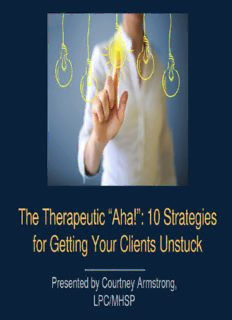
The Therapeutic “Aha!” PDF
Preview The Therapeutic “Aha!”
The Therapeutic “Aha!”: 10 Strategies for Getting Your Clients Unstuck Presented by Courtney Armstrong, LPC/MHSP Courtney Armstrong LPC, NBCCH Licensed Professional Counselor 20 years • exp. Owner: Tamarisk: A Center for Mind-Body • Therapy in Chattanooga, TN Trauma and Grief Specialist • National Certified Fellow of Clinical • Hypnotherapy Inner City New Orleans CBT not appropriate • Living in a “war zone” • Responded better to • creative, experiential interventions focused on realistic goals. The Therapeutic “Aha!” book How to evoke transformational • change with your clients. Experiential interventions that • engage both rational and experiential systems of brain. The Amygdala Made Me Do It Emotion overrides logic! (# 1 reason clients get stuck) Rational Brain vs. Emotional Brain Rational = 5% Emotional = 95% Illustration courtesy of NIMH Aha! Strategy #1: Engage the Emotional Brain © 2014 Penelope Randolph/Randolph Design Group Emotional Brain is an Experiential Processor • Learns from experience, association and repetition. • Intelligent, but thinks like an animal or small child. • Implicit, procedural memory. Rational System Experiential System 1. Solves problems by conscious 1. Solves problems by what has reasoning. been learned from life experiences. 2. Verbal: Encodes information in 2. Nonverbal: Encodes information words and numbers. through senses, images, feelings, sounds, smells, and taste. 3. Motivated by what is perceived 3. Motivated by survival– pursuing as logical and accurate. pleasure and avoiding pain. 4. Cause & effect relationship 4. Associative connections between among stimuli, responses, and stimuli, responses, and outcomes. outcomes. 5. Behavior mediated by 5. Behavior mediated by automatic conscious appraisal of events. representations of events and feelings. 6. Slower processing and capable 6. Rapid processing: oriented of long-delayed action. toward immediate action, impulsive . 7. Requires validation by logic and 7. Self-evidently valid: experiencing evidence. is believing. Epstein, S. (2014) Cognitive-Experiential Theory, p. 12
Description: